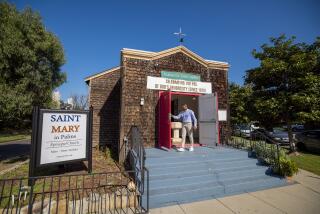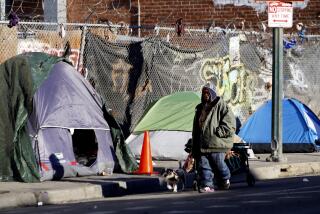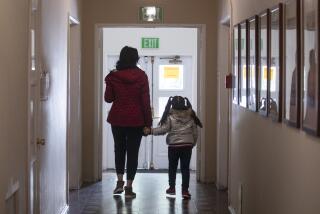Churches Will Open Doors to Homeless : Santa Clarita: A program supported by 15 congregations will begin Friday night and continue through March.
- Share via
Volunteer workers at a Santa Clarita religious charity that feeds the hungry recently noticed a disturbing trend: More and more of the people they fed said they were living in cars, in motor homes without electricity or running water, or sleeping under bridges and overpasses.
In surveys they took in the course of serving 1,300 people each month, the volunteers identified 70 families as having no permanent address. What they found even more disturbing was that many of the homeless lived in these places with their children.
In response, the volunteers have formed the Santa Clarita Interfaith Coalition Shelter Program, which will open in a church hall Friday night.
Under the program, four churches will open their facilities on a revolving basis Wednesday through Saturday to serve as one-night shelters, and three others will provide hot meals in a pilot program that will last through the end of March to get the homeless off the streets during the cold winter months.
Next winter, the churches plan to operate the shelter program from Nov. 1 to March 31, said Steve Spiker of the Church of Jesus Christ of Latter-day Saints.
“We just decided that they’ll be better off in a building,” even without beds, said Jani Fink, who is coordinating the setup of the shelters and is also a volunteer at the Santa Clarita Valley Food Pantry, the charity that feeds the hungry.
She has been scrambling the last two weeks making preparations, such as trying to gather 100 blankets from members of the 15 churches involved in the coalition, making arrangements at each site, and making sure there is food for snacks and breakfast each day.
The shelter is the brainchild of Spiker and the Rev. Lynn Jay of St. Stephen’s Episcopal Church in Valencia.
Spiker said they’re not sure how many people to expect the first night.
“The homeless have their own network of communication, and the word spreads,” Spiker said. “So we really don’t know what to expect Friday night. But we’ll be ready for them.”
The first guests will arrive for dinner at 6:30 at the Mormon church on Bouquet Canyon Road, where they will be screened by a volunteer, Spiker said. Shelter rules prohibit those who use drugs or alcohol, or who exhibit obviously violent behavior.
After a dinner prepared by church members, they will go down the street to the Santa Clarita United Methodist Church, where they will be given blankets and places to sleep in the church’s community hall.
After a light breakfast in the morning, they must help tidy up and be out of the facility by 7 a.m. Volunteers will give them a bag lunch with a peanut butter and jelly sandwich and fruit for the road.
The Santa Clarita program is modeled on the shelter run by the Simi Valley Interfaith Coalition for the Homeless and Needy, which is completing its fourth winter of operation.
“Except for some snags, for the most part, it works very well because of some very, very dedicated volunteers,” said the Rev. Barbara Mudge, vicar of St. Francis of Assisi Church of Simi Valley and director of the Simi Valley shelter program.
The fact that the shelter is located at a different church each night, as it will be in Santa Clarita, has not been confusing to the homeless in Simi Valley, Mudge said. The city of Simi Valley, in fact, likes it that way because “it keeps them moving and so it keeps them from getting” established in one neighborhood, she said.
Spiker said the homeless problem in Santa Clarita has been overlooked because “there are not that many who sleep on the streets or the bus stop. A lot of people sleep in their cars, so you’re not going to notice them.
“But we’ve really become more aware of them because of the food pantry.”
Fink pointed out the irony of living in an affluent community and still having a homeless problem.
“How can this be happening? I mean, I live with a bunch of doctors, lawyers and professional people. It shouldn’t be that way,” she said.
“We’re not a poor community out here. There shouldn’t be people out on the streets.”
More to Read
Sign up for Essential California
The most important California stories and recommendations in your inbox every morning.
You may occasionally receive promotional content from the Los Angeles Times.










